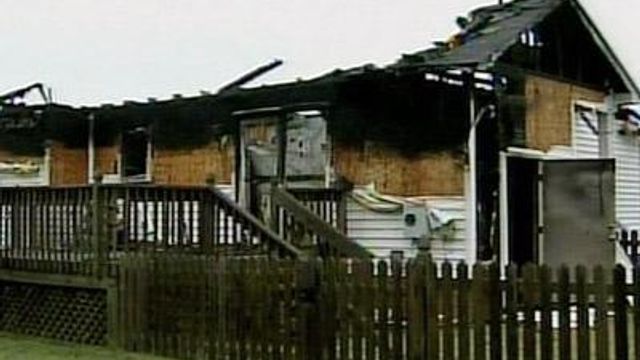Storms roll through state
Storms moved through the state Tuesday afternoon – toppling trees, downing power lines and bringing lightning that damaged homes.
In Johnston County, a vacant house in the Buffalo Creek subdivision of Zebulon caught fire after it was hit by lightning.
Nearby, another home on Amsterdam Drive was also damaged when it was struck by lightning.
“You can question it all day long, but you just have to thank the Lord we weren’t home and the family is safe. It is a material possession and can be replaced,” homeowner Trent Sherrill said.
Four of the family’s cats were rescued by firefighters. There were no injuries.
There were also reports of fallen trees and downed power lines across Johnston County.
The National Weather Service issued severe thunderstorm warnings Tuesday afternoon as the storms developed across the state.
WRAL Chief Meteorologist Greg Fishel warned the storms were slow moving and producing a large amount of lightning and hail.
A cold front Wednesday will bring another chance of scattered afternoon and evening storms. Highs will be in the lower 90s.
Thursday will bring partly cloudy skies and cooler weather.
Heat advisories issued across the state
Tuesday's storms came on the heels of a heat advisory was issued for much of the state as temperatures reached into the upper 90s with a heat index in the 100s.
From the American Red Cross:
Signs of heat-related illnesses include nausea, dizziness, flushed or pale skin, heavy sweating and headaches. Victims of heat-related illness should be moved to a cool place, given cool water to drink and ice packs or cool wet cloths should be applied to the skin. If a victim refuses water, vomits or loses consciousness, call 911 or your local emergency number immediately.
Preventing Heat-Related Illness
- Dress for the heat. Wear lightweight, light-colored clothing. Light colors will reflect away some of the sun's energy. It is also a good idea to wear hats or to use an umbrella.
- Drink water. Carry water or juice with you and drink continuously even if you do not feel thirsty. Avoid alcohol and caffeine, which dehydrate the body.
- Eat small meals and eat more often. Avoid foods that are high in protein which increase metabolic heat.
Avoid using salt tablets unless directed to do so by a physician. - Slow down. Avoid strenuous activity. If you must do strenuous activity, do it during the coolest part of the day, which is usually in the morning between 4:00 a.m. and 7:00 a.m.
- Stay indoors when possible.
- Take regular breaks when engaged in physical activity on warm days. Take time out to find a cool place. If you recognize that you, or someone else, is showing the signals of a heat-related illness, stop activity and find a cool place. Remember, have fun, but stay cool!
- Stages of Heat-Related Illness
Stages of Heat-Related Illness
Heat-related illness usually comes in stages. The signal of the first stage is heat cramps in muscles. These cramps can be very painful.
If you are caring for a person who has heat cramps, have him or her stop activity and rest. If the person is fully awake and alert, have him or her drink small amounts of cool water or a commercial sports drink.
Gently stretch the cramped muscle and hold the stretch for about 20 seconds, then gently massage the muscle. Repeat these steps if necessary.
If the victim has no other signals of heat-related illness, the person may resume activity after the cramps stop.
The signals of the next, more serious stage of a heat-related illness (often called heat exhaustion) include:
- Cool, moist, pale skin (the skin may be red right after physical activity).
- Headache.
- Dizziness and weakness or exhaustion.
- Nausea.
- The skin may or may not feel hot.
The signals of the late stage of a heat-related illness (often called heat stroke) include:
- Vomiting.
- Decreased alertness level or complete loss of consciousness.
- High body temperature (sometimes as high as 105 degree).
- Skin may still be moist or the victim may stop sweating and the skin may be red, hot and dry.
- Rapid, weak pulse.
- Rapid, shallow breathing.
This late stage of a heat-related illness is life-threatening. Call 911 or the local emergency number.
General Care for Heat Emergencies
- Cool the body
- Give fluids
- Minimize shock
For heat cramps or heat exhaustion: Get the person to a cooler place and have him or her rest in a comfortable position. If the person is fully awake and alert, give a half glass of cool water every 15 minutes.
Do not let him or her drink too quickly. Do not give liquids with alcohol or caffeine in them, as they can make conditions worse. Remove or loosen tight clothing and apply cool, wet cloths such as towels or wet sheets.
Call 911 or the local emergency number if the person refuses water, vomits or loses consciousness.
For heat stroke: Heat stroke is a life-threatening situation. Help is needed fast. Call 9-1 or your local EMS number. Move the person to a cooler place.
Quickly cool the body. Wrap wet sheets around the body and fan it. If you have ice packs or cold packs, wrap them in a cloth and place them on each of the victim's wrists and ankles, in the armpits and on the neck to cool the large blood vessels.
(Do not use rubbing alcohol because it closes the skin's pores and prevents heat loss.) Watch for signals of breathing problems and make sure the airway is clear. Keep the person lying down.











